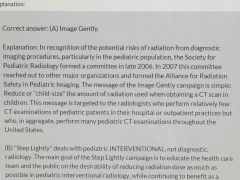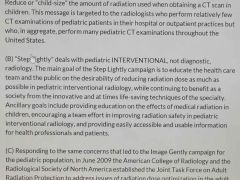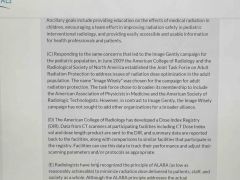![]()
![]()
![]()
Use LEFT and RIGHT arrow keys to navigate between flashcards;
Use UP and DOWN arrow keys to flip the card;
H to show hint;
A reads text to speech;
54 Cards in this Set
- Front
- Back
|
A. National Patient Safety Advisory Group Goals
Radiology Practices |
- Use Two Patient Identifiers When Providing Care, Treatment, and Services
-Report Critical Results of Tests of Diagnostic Procedures on a Timely Basis
-Label All Medications Sterile Field |
|
|
A. National Patient Safety Advisory Group Goals
Radiology Practices |
-Maintain & Communicate Accurate Patient Medication Information -Comply with Hand Hygiene Guidelines -Guidelines for Infections Prevention -Central Line Infection Prevention -Conduct Pre-Procedure Verification Process -Mark Procedure Site -Performa a Time Out Before Procedure |
|
|
B. Epidemiology of Error
- to Err is Human -44 to 98 thousand/year deaths |
Most Errors Were Felt to Be System Errors |
|
|
C. Types of Error
1. Diagnostic |
1. Diagnostic
a. Error or Delay in Diagnosis b. Failure to Employ Indicated Tests c. Use of Outmoded Tests or Therapy d. Failure to Act on the Results of Monitoring or Testing |
|
|
C. Types of Error
2. Treatment |
2. Treatment a. Error in performance of operation , procedure or test. b. Error in administering the treatment c. Error in dose or method using a drug d. Avoidable delay in treatment or in responding to an abnormal test. e. Inappropriate (not indicated) care |
|
|
C. Types of Error
3. Preventive |
3. Preventive
a. Failure to Provide Prophylactic Treatment b. Inadequate Monitoring or Follow-up of treatment |
|
|
C. Types of Error
4. Other |
4. Other
a. Failure of Communication b. Equipment Failure c. Other System Failure |
|
|
D. Ten Rules for Redesign
|
1. Care Base Continuous Healing Relationships 2. Care Customized for Patient Needs/Values 3. Patient is Source of Control 4. Knowledge is Shared /Information Flows 5. Decision Making is Evidence Based
|
|
|
D. Ten Rules for Redesign |
6. Safety is a System Property 7. Transparency is Necessary 8. Needs are anticipated 9. Waste is Continuously Decreased 10. Cooperation among clinicians is a priority. |
|
|
E. Systems Thinking |
1. Definition of systems-Providers, patients, support staff, clinical progresses, administrative processes, technology, and information that all come together to produce care. 2. Multiple Layers of the System that Affect Safety-Nation, state, hospital, caregiving unit 3. Error Mitigation versus Recovery
|
|
|
F. Human Factors
1. Background Human errors |
Human Factors Engineering -human factors engineering focuses on how systems work in actual practice, with real—and fallible—human beings at the controls, and attempts to design systems that optimize safety and minimize the risk of error in complex environments. |
|
|
F. Human Factors
2. Applications of Human Factors Engineering to Improving Safety
Techniques & Tools |
a.-Usability Testing- Simulated Clinical scenarios prior to implementation b.-Identify Workarounds- Avoiding Workarounds c.-Forcing Functions- i.e. removal medication from floor d.-Standardization- Equipment and Processes-- Increase Reliability |
|
|
F. Human Factors
2. Applications of Human Factors Engineering to Improving Safety
Techniques & Tools |
example: Safe Surgery Checklist Before Induction of anesthesia a. Confirm patient ID, Site, Procedure, Consent b. Site Marking/c. Check anesthesia machine d. Pulse Ox e. Allergies f. Difficult Airway or Aspiration Risk> g. Risk of Significant Blood Loss |
|
|
F. Human Factors
2. Applications of Human Factors Engineering to Improving Safety
Techniques & Tools |
Before skin incision h. Confirm all team members have introduced themselves by name and role -i. Confirm patient name, procedure, and site of incision -j. Antibiotic prophylaxis? -k. Review anticipated critical events -l. Review patient-specific concerns related to anesthesia -m. Confirm sterility of equipment-n. imaging available? |
|
|
F. Human Factors
2. Applications of Human Factors Engineering to Improving Safety
Techniques & Tools |
Before patient leaves operating room xv. Nurse confirms name of procedure. xvi. Nurse confirms instrument, sponge, and needle counts. xvii. Nurse confirms specimen labeling. xviii. Any equipment problems to be addressed? xix. Concerns for recovery or management |
|
|
F. Human Factors
2. Applications of Human Factors Engineering to Improving Safety
Techniques & Tools |
e. Resiliency Efforts Unexpected Events Are Likely to Occur Risk Management Steps in place to bounce back |
|
|
G. Communication
|
1. Removing Barriers That Affect Patient-Practitioner Interactions 2. Disclosure of Adverse Events a. Telling Patient/Family what happened in terms they can understand. b. Taking Responsibility--c. Apologizing--d. Explaining What Will Be Done To Prevent Similar Errors, Improved Transition, Specific Strategies |
|
|
H. Culture of Safety |
-acknowledgment of the high-risk nature of an organization’s activities;a blame-free environment where individuals are able to report errors or near misses without fear of reprimand or punishment; encouragement of collaboration across ranks and disciplines to seek solutions to patient safety problems; plan to fix. |
|
|
I. Definitions |
1. Active Error- Someone at the Front Line 2. Adverse Drug Event (ADE)- Not Necessarily Indicate an error or poor quality of care. 3. Adverse Drug Reaction 4. Adverse Event- Any Injury From Medical Care 5. Authority Gradient 6. Blunt End-- People Not Directly Taking Care 7. Close Call (Near Miss) |
|
|
I. Definitions |
8. Latent Error 9. Mistakes- 10. Potential ADE Adverse Drug Event 11. Sharp End- People Directly Taking Care of Patient 12. Sentinel Event- unexpected occurrence involving death, or serious physical or psychological injury, Need Investigation. |
|
|
J. Tools For Evaluating Risk and Adverse Events |
1. Failure Mode and Effects Analysis FMEA
Prospectively Identify error risk |
|
|
J. Tools For Evaluating Risk and Adverse Events |
2. Root Cause Analysis
Structured method to Analyze Serious Adverse Events |
|
|
J. Tools For Evaluating Risk and Adverse Events |
3. Medication Reconciliation |
|
|
K. Periprocedural Care: Patient ID, Informed Consent, Time Out |
1. Patient Identifier Two Identifiers 2. Patient Assessment 3. Informed Consent 4. Time Out- Mark Site 5. Hand Washing Sterility |
|
|
L. Conscious Sedation Continuum of Sedation Reversal Drugs |
“levels” are truly a continuum. -Moderate sedation/analgesia: A minimally depressed level of consciousness induced by the administration of pharmacologic agents in which the patient retains a continuous and independent ability to maintain protective reflexes and a patent airway and to be aroused by physical or verbal stimulation. |
|
|
L. Conscious Sedation Continuum of Sedation Reversal Drugs |
-Deep sedation/analgesia: A drug-induced depression of consciousness during which patients cannot be easily aroused but respond purposefully following repeated or painful stimulation. The ability to independently maintain ventilatory function may be impaired. Patients may require assistance in maintaining a patent airway, and ventilation Inad. CV ok. |
|
|
L. Conscious Sedation Continuum of Sedation Reversal Drugs Classification 1,2 okey 3,4 Need anesth. |
Class I - A normal healthy patient; Class II - A patient with mild systemic disease; Class III - A patient with bad systemic disease; Class IV - A patient with severe systemic disease that is a constant threat to life; Class V - A moribund Class VI - Dead |
|
|
L. Conscious Sedation Continuum of Sedation Reversal Drugs
Reversal for benzodiazepine, Versed
|
Flumazenil (Romazicon) MOA Initial dose 0.2mg IV (8-15mcg/Kg) usually reverses the CNS effects of benzos w/in 2 minutes. |
|
|
L. Conscious Sedation Continuum of Sedation Reversal Drugs
Reversal for Opioid, Demerol, Fentanyl |
Narcan-- Naloxone Dose 1-4 ug/kg IV produces prompt reversal of opioid induced analgesia & depression of ventilation. Beware Frozen Chest Muscles Fentanyl |
|
|
M. MR Safety |
Four Zones
Zone 1. Access is Unrestricted Zone 2. Public Accessible, Screen Patients Zone 3. Potential Danger (Control Room) Zone 4. Scanner Room |
|
|
N. Contrast Reactions & Management |
1. Iodinated Contrast Risk a. prior contrast reaction 5 times higher b. Any other allergic history c. Shellfish not considered significant d. Atopy 2-3 times e. Asthma f. Cardiac Disease g. anxiety?? |
|
|
N. Contrast Reactions & Management
Pretreatment |
Premedication -Oral six hours before -Steroids -Prednisone 13, 7, 1 hour before -or Methylprednisolone 12 and 2 hours -H-antihistamine Benadryl IV steroids not helpful < 4-6 hours. |
|
|
N. Contrast Reactions & Management
Treatment: Urticaria |
Urticaria No Treatment Benadryl po, im, iv 25-50mg
If severe epinephrine 1:1000subq 0.1to 0.3 mg If No cardiac contraindications! |
|
|
N. Contrast Reactions & Management
Treatment: Facial or Laryngeal Edema |
Facial or Laryngeal Edema 1. O2 6-10 liters/min (via face mask) 2. Monitor EKG, O2 Sat, Blood Pressure 3. Brochial Dilators Albuterol 2-3 puffs 4. If Not Responsive- Give Subq epinephrine 0.1-0.3 mg 5. If Hypotensive- Give IV Epinephrine 1:10,000 1-3ml (=0.1-0.3mg) IV slowly, repeat up to 1mg. |
|
|
N. Contrast Reactions & Management
Treatment: Facial or Laryngeal Edema |
If Sat Less Than 88 Percent Call Code Team |
|
|
N. Contrast Reactions & Management
Treatment: Hypotension With Tachycardia |
Hypotension With Tachycardia 1. Legs Elevated 60 degree or more 2. Monitor 3. Give O2 6-10 ml/min (via mask) 4. Rapid IV Ringers or Normal Saline 5. Poorly Responsive- IV Epinephrine 1-10,000 1 mg, repeat as needed |
|
|
N. Contrast Reactions & Management
Treatment: Hypotension With Bradycardia |
Hypotension with Bradycardia (Vagal Reaction) 1. Airway O2 6-10 ml/min (via mask) 2. Moniter 3. Legs Elevated 60 Degrees or more 4. IV Access Rapid Ringers Normal Saline 5. Atropine 0.6 to 1mg slowly 6. Repeat 2-4 7. Repeat Atropine up to total dose 2-3 mg |
|
|
N. Contrast Reactions & Management
Treatment: Hypertension Severe |
Hypertension , Severe 1. O2 6-10 liters/min (via mask) 2. Moniter 3. Nitroglycerine 0.4mg tablet sublingual (may repeat x 3); or topical 2 percent ointment 4. No response, consider labetalol 20 mg IV, then 20-80 mg IV every 10 minutes up to 300 mg. 5. For Pheochromocytoma: Phentolamine 5mg |
|
|
N. Contrast Reactions & Management
Treatment: Seizure, Convulsion |
Seizure, Convulsion 1. Give O2 6-10 ml/min via mask. 2. Consider Valium 5mg IV or more, or Versed .5 to 1mg IV 3. If long effect, IV Dilantin infusion slowly 4. Watch for Respiratory Depression (benzodiazepine administration) |
|
|
N. Contrast Reactions & Management
Treatment: Pulmonary Edema |
Pulmonary Edema 1. Give O2 6-10ml/min via face mask. 2. Elevate Torso 3. Diuretics: Lasix 20-40mg IV slow Push 4. Consider Morphine 1-3mg IV |
|
|
Contrast Induced Nephropathy |
“a sudden deterioration in renal function following the recent intravascular administration of iodinated contrast medium in the absence of another nephrotoxic event.” |
|
|
Contrast Induced Nephropathy |
-The usual clinical course of CIN is a rise in serum creatinine within 24 hours of contrast administration, which peaks at about four days and returns to baseline within seven to 10 days.
-Development of permanent renal dysfunction is unusual. |
|
|
Contrast Induced Nephropathy d. |
Etiologies include renal hemodynamic changes (vasoconstriction) and direct tubular toxicity, either by an osmotic or chemotoxic mechanism.
Most studies have shown a risk of CIN of less than 10 percent, even in patients with moderate chronic kidney disease. |
|
|
Contrast Induced Nephropathy d. |
A suggested protocol per the ACR Contrast Manual is infusion at 100 ml/hr for 6-12 hours before contrast administration and 4-12 hours after contrast administration.
However, as with other studies related to CIN, most of the data relate to cardiac angiography. |
|
|
2. MR Contrast Agents |
Acute adverse reactions to gadolinium-based contrast media (GBCM) used in MRI are less frequent than reactions to iodinated contrast media
Fatal reactions to gadolinium chelate agents occur but are extremely rare.” |
|
|
2. MR Contrast Agents |
Patients with a prior reaction to GBCM (Gadolinium) have an eight-times increased risk of a subsequent reaction, which may be more severe than the first reaction.
Risk Factors Include Asthma, Other allergies, Including iodinated contrast media. risk 3.7% |
|
|
2. MR Contrast Agents |
Nephrogenic Systemic Fibrosis (NSF). The ACR Contrast Manual defines NSF as “a fibrosing disease, primarily identified in the skin and subcutaneous tissues but also known to involve other organs, such as the lungs, esophagus, heart, and skeletal muscles. |
|
|
2. MR Contrast Agents |
-----The combination of severe chronic kidney disease (Stage 4 [eGFR 15-29 ml/min/1.73 m2], Stage 5 [eGFR <15 ml/min/1.73 m2], and patients on dialysis) or acute kidney injury. ------ Higher doses and multiple doses of GBCM are believed to increase the risk of NSF, but cases have occurred with single administration of a standard dose of GBCM. |
|
|
2. MR Contrast Agents |
---Incidence of GSF has fallen to close to zero primarily by avoiding or severely limiting administration of GBCA to patients with an eGFR <30 ml/min/1.73 m2 or with acute kidney injury. ---If a GBCM must be administered, the lowest possible dose should be used and the agents with the highest association with NSF should be avoided. |
|
|
3. Extravasation |
Two severe complications may occur. --The most common is a compartment syndrome related to mechanical compression.
--The second severe complication is skin ulceration and tissue necrosis. |
|
|
III Professionalism & Ethics A. Attributes of Professionals |
dddddddd |
|
|
Image Gently |

|
|
|
What is step lightly? |

|
|
|
What is image wisely? |

Back (Definition) |

